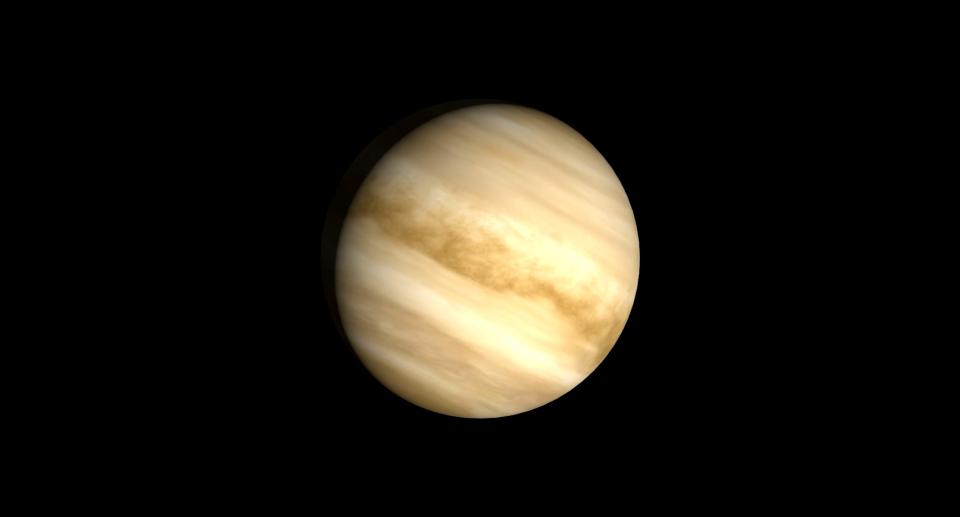When you buy through links on our articles, Future and its syndication partners may earn a commission.


Scientists have observed something unexpected in Venus’ atmosphere — an increase in the level of deuterium relative to hydrogen. Okay, sure, that doesn’t sound like the most exciting statement. However, the consequences of this discovery could actually upend our current understanding of the amber world.
As it turns out, it would affect our assumption that Venus is a perpetually barren, inhospitable planet. Here’s how.
“Venus is often called Earth’s twin due to its similar size,” said Hiroki Karyu, a researcher at Tohoku University and one of the study’s scientists, in a statement. “Despite the similarities between the two planets, it has evolved differently. Unlike Earth, Venus has extreme surface conditions.”
Liquid water is unable to exist in significant enough quantities due to the extreme temperatures and pressures beneath Venus’ thick cloud layers. “To put this into perspective, these altitudes have 150,000 times less water than comparable altitudes on Earth,” wrote the scientists in their study.
But that’s not to say this was always the case.
Deuterium and hydrogen are isotopes of one another, meaning they’re different forms of the same element, containing equal numbers of protons but different numbers of neutrons in their nuclei. This results in them having different atomic masses, but their chemical properties remain relatively the same.
Related: Venus may be able to support life, new atmospheric evidence suggests
A lot can be gleaned from isotopic ratios. Take carbon dating, for example, which is a powerful tool scientists use to glean the age of organic matter using relative proportions of the isotopes carbon-12 and carbon-14. The ratio of these isotopes in a material changes over time as carbon-14 radioactively decays and is not replaced.
Venus and Earth are believed to have had similar HDO/H2O ratios once upon a time, as both planets formed in a hot region of the early solar system where water couldn’t condense. Later, water is thought to have been delivered to the worlds by water-rich asteroids likely from the outer asteroid belt, which should have resulted in similar deuterium-to-hydrogen (D/H) ratios on both planets. This hypothesis is further supported by the comparable levels of other volatile elements, like carbon and nitrogen, between Venus and Earth.
But after poring through data from the Solar Occultation in the Infrared (SOIR) instrument on the Venus Express space probe (which was operational from 2006 to 2014) has placed a blip in this story. Scientists found that the ratio of HDO is now 120 times higher compared to H2O in Venus’ atmosphere. “This enrichment is primarily due to solar radiation breaking down water isotopologues in the upper atmosphere, producing hydrogen (H) and deuterium (D) atoms,” wrote the ESA scientists. “Since H atoms escape into space more readily due to their lower mass, the HDO/H2O ratio gradually increases.”
They also determined that the concentration of water molecules, both H2O and HDO, increases with altitude, specifically between 70 and 110 kilometers (43 and 68 miles) above Venus’ surface. Further, they found that the ratio of HDO to H2O becomes extremely elevated at these altitudes, more than 1,500 times higher than what is found in Earth’s oceans. This indicates that Venus’ atmosphere contains much more deuterium-rich water compared to Earth, pointing to significant differences in the atmospheric processes of the two planets.
The team speculates that these processes might be controlled by climate mechanisms involving sulfuric acid (H2SO4) aerosols, which make up a majority of Venus’ clouds.
“These aerosols form just above the clouds, where temperatures drop below the sulphurated water dew point, leading to the formation of deuterium-enriched aerosols,” explained the scientists. “These particles rise to higher altitudes, where increased temperatures cause them to evaporate, releasing more significant fraction of HDO compared to H2O. The vapour then is transported downwards, restarting the cycle.”
Related Stories:
— Jupiter-bound JUICE probe slingshots by Earth on way to Venus (photos)
— How ‘Earth’s twin’ Venus lost its water and became a hellish planet
— Zoozve — the strange ‘moon’ of Venus that earned its name by accident
As to how the findings will have broader implications for our understanding of the planet? First, the team hopes future studies will consider how the ratio of deuterium to hydrogen (D/H) changes with altitude when calculating the total amounts of these gases in Venus’ atmosphere. Second, the way D/H changes with altitude affects how quickly hydrogen and deuterium escape into space. For example, high in the atmosphere, much more deuterium is released than expected, which can impact the overall D/H ratio if some of this deuterium escapes.
This means that, to accurately understand how Venus’ atmosphere has evolved and how much water it might have lost over time, scientists need to use detailed models that account for these altitude changes.

